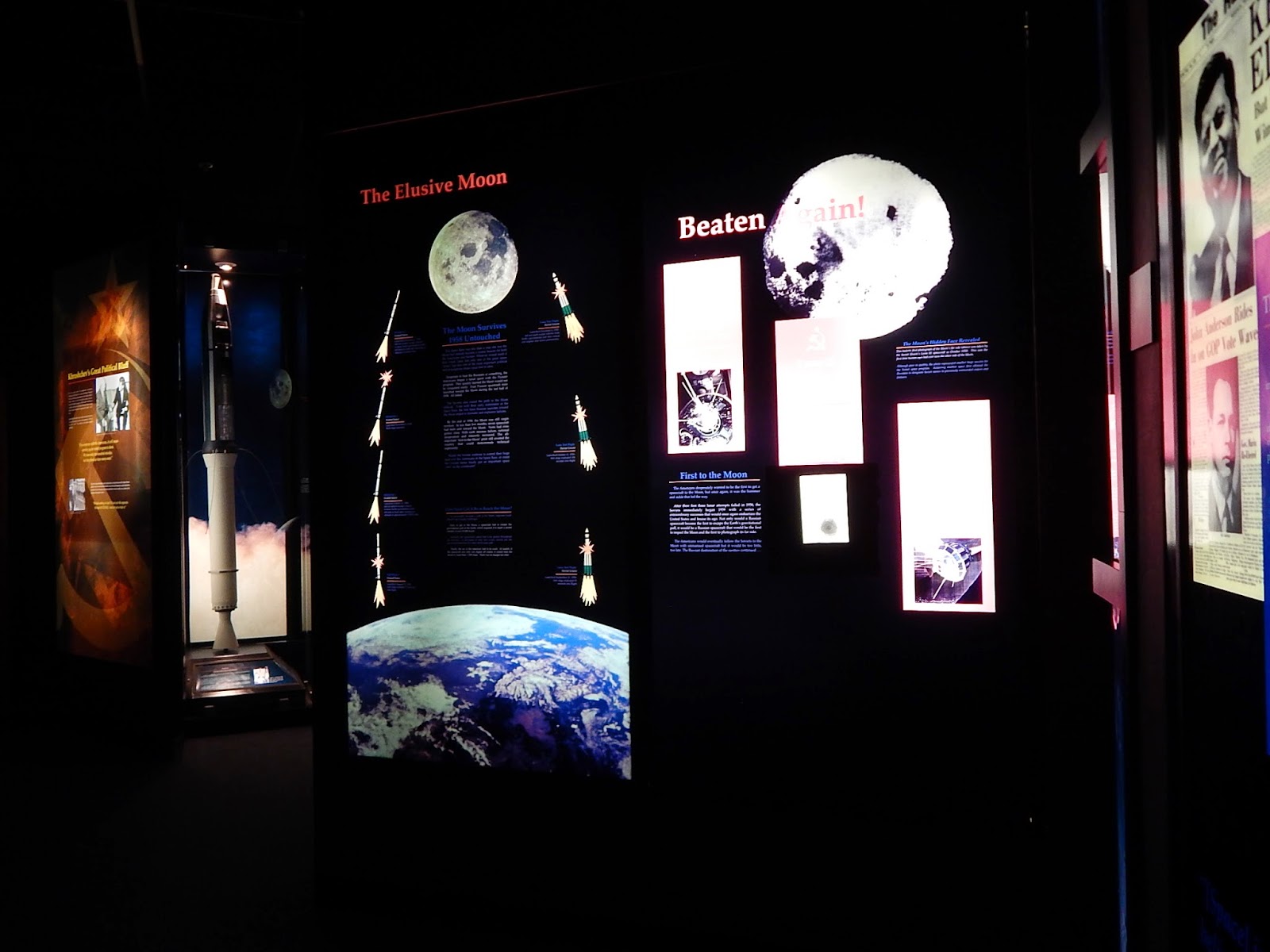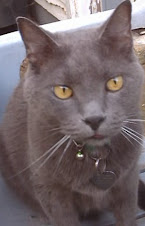Today we pick up where we left off at the Cosmosphere, a space museum. Part 1 can be seen here if you missed it. Today will be a bit shorter, with about 50 photos. I find a good place to stop, and that's where I leave you. I'll pick up Part 3 later next week, since the first of every week is fairly busy art wise.
 After WWII and at the beginning of the Cold War,
After WWII and at the beginning of the Cold War,  America and Russia both wanted to
America and Russia both wanted to  But there were a lot of obstacle to overcome, one of which was to fly at supersonic speed. Granted, breaking the sound barrier is done often today, but back in 1947, it had not been accomplished.
But there were a lot of obstacle to overcome, one of which was to fly at supersonic speed. Granted, breaking the sound barrier is done often today, but back in 1947, it had not been accomplished. At least, not until Chuck Yeager achieved slightly better than Mach 1 on October 14, 1947 less than a month after the U.S. Air Force became a new and separate service. He named his Bell X-1 "Glamorous Glennis" for his wife. The replica of "Glamorous Glennis" shown above was used in the movie "The Right Stuff."
At least, not until Chuck Yeager achieved slightly better than Mach 1 on October 14, 1947 less than a month after the U.S. Air Force became a new and separate service. He named his Bell X-1 "Glamorous Glennis" for his wife. The replica of "Glamorous Glennis" shown above was used in the movie "The Right Stuff." One of Yeager's original flight suits, it was worn in space.
One of Yeager's original flight suits, it was worn in space. There were many Bell X planes, including the X-1 and X-1A through E.
There were many Bell X planes, including the X-1 and X-1A through E. This is the rocket engine of an X-15. It has been in space and is not just a model.
This is the rocket engine of an X-15. It has been in space and is not just a model. Although it's too hard to read because of the dim lighting, October 4, 1957 was the day the Soviets launched Sputnik 1. America had lost its opportunity to be first in the race for space.
Although it's too hard to read because of the dim lighting, October 4, 1957 was the day the Soviets launched Sputnik 1. America had lost its opportunity to be first in the race for space. This model of Vanguard 1 denotes the fourth artificial orbital satellite launched, and the first solar powered satellite. Although communication with it was lost in 1964, it remains the oldest man made satellite still in orbit. Sputniks 1 and 2, and Explorer 1, the first US satellite, preceded it.
This model of Vanguard 1 denotes the fourth artificial orbital satellite launched, and the first solar powered satellite. Although communication with it was lost in 1964, it remains the oldest man made satellite still in orbit. Sputniks 1 and 2, and Explorer 1, the first US satellite, preceded it. Because then US president Eisenhower was slow to respond, the US found itself entering the space race late. Under the Truman administration, the American defense budget had quadrupled,
and Eisenhower moved to reduce military spending by a third, which included the space race, while
continuing to fight the Cold War.
Because then US president Eisenhower was slow to respond, the US found itself entering the space race late. Under the Truman administration, the American defense budget had quadrupled,
and Eisenhower moved to reduce military spending by a third, which included the space race, while
continuing to fight the Cold War. Fueled by the arms race and the growing threat of nuclear weapons,
wide-ranging espionage and counter-espionage between the two countries, the space race heated up as the Soviets continued to prove their superiority.
Fueled by the arms race and the growing threat of nuclear weapons,
wide-ranging espionage and counter-espionage between the two countries, the space race heated up as the Soviets continued to prove their superiority.  Although never flown, this is an original flight-ready backup of Sputnik 1.
Although never flown, this is an original flight-ready backup of Sputnik 1. In 1958, the U.S. launched Explorer I, designed by
the U.S. Army under the direction of Wernher von Braun.
In 1958, the U.S. launched Explorer I, designed by
the U.S. Army under the direction of Wernher von Braun.
 That same year, Eisenhower signed a public order
creating the National Aeronautics and Space Administration (NASA), the US's
federal agency dedicated to space exploration.
That same year, Eisenhower signed a public order
creating the National Aeronautics and Space Administration (NASA), the US's
federal agency dedicated to space exploration. Failure soon became an option.
Failure soon became an option.  A recording of Kennedy's famous "Ich bin ein Berliner" speech played over and over as we walked
A recording of Kennedy's famous "Ich bin ein Berliner" speech played over and over as we walked  around this display.
around this display.  Khrushchev's famous "Whether you like it or not, history is on our side. We will bury you"speech played here, among
Khrushchev's famous "Whether you like it or not, history is on our side. We will bury you"speech played here, among  an original section from the Berlin Wall. In fact, it was the last section removed.
an original section from the Berlin Wall. In fact, it was the last section removed.  Model of a Saturn rocket.
Model of a Saturn rocket.  Lifesize model of a Saturn rocket.
Lifesize model of a Saturn rocket. The blockhouse is the launch control area which is filled with instrumentation and rudimentary computers. It was first used in 1957 and was located at then Cape Canaveral.
The blockhouse is the launch control area which is filled with instrumentation and rudimentary computers. It was first used in 1957 and was located at then Cape Canaveral.  The Mercury-Redstone 1 was the first unmanned flight test in the Mercury program and the first attempt to launch a Mercury spacecraft. it was launched on November 21, 1960 from Cape Canaveral, Florida. The launch failed and has been referred to as the "four-inch flight", since it only got about four inches off the ground. All that had been launched was the escape rocket.
The Mercury-Redstone 1 was the first unmanned flight test in the Mercury program and the first attempt to launch a Mercury spacecraft. it was launched on November 21, 1960 from Cape Canaveral, Florida. The launch failed and has been referred to as the "four-inch flight", since it only got about four inches off the ground. All that had been launched was the escape rocket.Mercury-Redstone 3, or Freedom 7 was the first US human spaceflight, on May 5, 1961. It was piloted by Alan Shepard, the first American in space, although he didn't achieve orbit.
Mercury-Redstone 4 was the second US human spaceflight, on July 21, 1961. The spacecraft was named Liberty Bell 7 and piloted by astronaut Virgil "Gus" Grissom. The spacecraft was carried into orbit by a Mercury-Redstone rocket, which is located on the side of the Cosmosphere close to where we entered.
After the Liberty Bell 7 landed in the ocean, the hatch blew prematurely. Due to unforeseen and unplanned circumstances, the recovery crew focused on the spacecraft, rather than Grissom, who almost died as a result. Further, the spacecraft sank to the bottom of the ocean, where it stayed until it was retrieved in 1999, at which time it was transferred to the Cosmosphere, where it was taken apart, cleaned, and restored. You will see it later, also. As an aside, the recovery was sponsored by the Discovery Channel.
 The Titan Gemini Launch Vehicle was considered expendable, and, if my notes are correct, one was built for each of 12 Gemini missions.
The Titan Gemini Launch Vehicle was considered expendable, and, if my notes are correct, one was built for each of 12 Gemini missions. This is part of the controls in a Blockhouse.
This is part of the controls in a Blockhouse. I failed to note this piece that had flown in space.
I failed to note this piece that had flown in space. I was the only one of us three who ventured outside to take photos of the Titan missile. It was unbelievably huge.
I was the only one of us three who ventured outside to take photos of the Titan missile. It was unbelievably huge. Some of these photos may seem redundant,
Some of these photos may seem redundant,  but anyone who knows me, knows I'm all about machines and how they are made.
but anyone who knows me, knows I'm all about machines and how they are made. My back was hurting by this time (I hurt it nearly two weeks earlier), and I knew I could walk to the top with no trouble, but I might have a hard time coming back down.
My back was hurting by this time (I hurt it nearly two weeks earlier), and I knew I could walk to the top with no trouble, but I might have a hard time coming back down.  To top it off, as some of you saw in Part 1, I was also wearing a loose fitting dress, not the best thing to be climbing in, since I could envision some kid standing below and staring up my dress.
To top it off, as some of you saw in Part 1, I was also wearing a loose fitting dress, not the best thing to be climbing in, since I could envision some kid standing below and staring up my dress.This is a good place to stop, so I will. We are NOT finished with the Cosmosphere, although I have eliminated more than a few photos where people walked in front of me, or put their arm in front of my camera. As promised, Part 3 will be the middle of next week, more than likely Wednesday.


















































































.JPG)













































6 thoughtful remarks:
WOW... it really is exciting !
Happy Sunday dear Elizabeth!
This really does look like a fantastic museum - things that we can remember bits of, but were too young to understand! Thanks for taking me!! Chrisx
ps no comments for a few days - going to the land of little connectivity in the morning(our caravan!)
Another interesting and informative post. Quite a museum! :)
This is a fun history of the race to space! You take excellent notes and add just enough commentary to explain the photo without too much detail. Thanks!
Another amazing post Elizabeth. I was 4 months old when Sputnik 1 was launched i am a Gemini and i saw, with the rest of the world, the fall of the Berlin Wall.
Fascinating information, amazing images and am thankful you are sharing your great adventure with us.
Looking forward to part three very much:-) xxx
wow, your space Museum visit sure was exciting! and along with your photos you can visit it many times more, diggin´ in even deeper! thanks for sharing your adventure, elizabeth!
Post a Comment